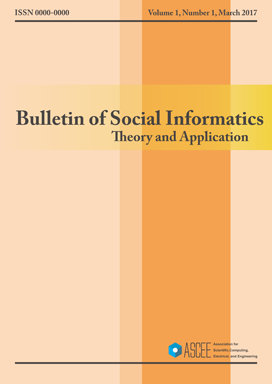Forecasting IoT Pollution Data Using Forward Newton for Sustainable Green Environment
DOI:
https://doi.org/10.31763/businta.v6i1.545Keywords:
Internet of Things, Air pollution, Newton method, Future trends, Green environmentAbstract
IoT (Internet of Things) technology is growing rapidly because of its ease of
use and low cost. One of the widely used IoT technologies is air pollution
loggers in big cities. This technology is often found installed in places that
are easily seen to display pollution information. The stored data is not
processed so that the data seems useless. The data contains valuable
information as long as it is extracted with the right method. The pollution
data is consistent with time, so the use of the advanced newton method is
suitable because the prediction will involve future trends. The results of this
study indicate that from 12,432 the amount of data gives the result that in the
next 1 year the amount of CO2 levels will increase by 3%, this needs to be
taken into account by planting trees around the location so that the
environment becomes friendly to human health.
References
J. A. Becerra, J. Lizana, M. Gil, A. Barrios-Padura, P. Blondeau, and R. Chacartegui, “Identification of potential indoor air pollutants in schools,†J. Clean. Prod., vol. 242, p. 118420, Jan. 2020, doi: 10.1016/j.jclepro.2019.118420.
B. W. Wirtz, J. C. Weyerer, and F. T. Schichtel, “An integrative public IoT framework for smart government,†Gov. Inf. Q., vol. 36, no. 2, pp. 333–345, Apr. 2019, doi: 10.1016/j.giq.2018.07.001.
F. John Dian, R. Vahidnia, and A. Rahmati, “Wearables and the Internet of Things (IoT), Applications, Opportunities, and Challenges: A Survey,†IEEE Access, vol. 8, pp. 69200–69211, 2020, doi: 10.1109/ACCESS.2020.2986329.
O. Said, Z. Al-Makhadmeh, and A. M. R. Tolba, “EMS: An Energy Management Scheme for Green IoT Environments,†IEEE Access, vol. 8, pp. 44983–44998, 2020, doi: 10.1109/ACCESS.2020.2976641.
N. Uskowi, “Temperature Rising: Iran’s Revolutionary Guards and Wars in the Middle East,†2018. Available at : ndupress.ndu.edu.
M. LOPEZ, A. GOMEZ, G. MULLER, E. W.- MedRxiv, and U. 2022, “Climate change and the rising incidence of dengue in Argentina,†medrxiv.org, doi: 10.1101/2022.06.03.22275954.
H. Stevens, P. Beggs, … P. G.-I. journal of, and undefined 2019, “Hot and bothered? Associations between temperature and crime in Australia,†Springer. doi : 10.1007/s00484-019-01689-y.
V. Suma, R. Shekar, K. A.-2019 3rd International, and undefined 2019, “Gas leakage detection based on IOT,†ieeexplore.ieee.org. doi : 10.1109/ICECA.2019.8822055.
P. Kumar, A. K.-I. J. of Engineering, and undefined 2019, “Design of Gas Detection and Monitoring System using IoT,†academia.edu. doi : 10.17577/IJERTV8IS110193
J. B. A. Gomes, J. J. P. C. Rodrigues, R. A. L. Rabêlo, N. Kumar, and S. Kozlov, “IoT-enabled gas sensors: Technologies, applications, and opportunities,†mdpi.com, 2019, doi: 10.3390/jsan8040057.
Y. Romm, G. D.-J. of P. Conference, and undefined 2021, “Piecewise interpolation solution of ordinary differential equations with application to numerical modeling problems,†iopscience.iop.org, vol. 1902, p. 12130, 2021, doi: 10.1088/1742-6596/1902/1/012130.
A. Rakshit and B. Banerjee, “Analysis The Internal Pressure Of The Thin Cylindrical Shell By Newton’s Forward Interpolation,†irjmets.com, pp. 2582–5208. Available at : irjmets.
A. R. Mohammed, M. Abdel-Aal, K. S. Hassan, and M. A. M. Abdel-Aal, “Moving Average Smoothing for Gregory-Newton Interpolation: A Novel Approach for Short-Term Demand Forecasting,†2022. doi : 10.1016/j.ifacol.2022.09.499.
F. Heriyanti, A. I.-I. C. S. M. Science, and undefined 2020, “Design of logistics information system in the finished product warehouse with the waterfall method: review literature,†iopscience.iop.org, doi: 10.1088/1757-899X/801/1/012100.
S. N. Hidayati, “Application of Waterfall Model In Development of Work Training Acceptance System,†2020, doi: 10.29407/intensif.v4i1.12976. doi: 10.1016/j.ifacol.2022.09.499.
A. Sinha, P. D. Electronics, M. E. & Nano, and undefined 2021, “Agile Methodology Vs. Traditional Waterfall SDLC: A case study on Quality Assurance process in Software Industry,†ieeexplore.ieee.org. doi: 10.1109/IEMENTech53263.2021.9614779.
M. K.-R. of B. & F. Studies and undefined 2018, “Best practices in systems development lifecycle: An analyses based on the waterfall model,†papers.ssrn.com, vol. 9, no. 1, pp. 77–84, 2018. Available at : papers.ssrn.com.
C. Burr, N. Cristianini, J. L.-M. and machines, and undefined 2018, “An analysis of the interaction between intelligent software agents and human users,†Springer. doi : 10.1007/s11023-018-9479-0.
E. Gebka, J. Crusoe, and K. Ahlin, “To Capture the Information Needs of End-Users of Open Data: Guidelines to design methods,†2021. doi: 10.5334/dsj-2021-037.
C. Burr, N. Cristianini, and J. Ladyman, “An Analysis of the Interaction Between Intelligent Software Agents and Human Users,†Minds Mach., vol. 28, no. 4, pp. 735–774, Dec. 2018, doi: 10.1007/S11023-018-9479-0.
S. Almeyda, C. Zapata Del RÃo, and D. Cohn, “Integration of User Experience and Agile Techniques for Requirements Analysis: A Systematic Review,†Lect. Notes Comput. Sci. (including Subser. Lect. Notes Artif. Intell. Lect. Notes Bioinformatics), vol. 12779 LNCS, pp. 187–203, 2021, doi: 10.1007/978-3-030-78221-4_13.
R. Prasath, R. R.-2021 2nd I. C. on, and undefined 2021, “Autonomous Application in Requirements Analysis of Information System Development for Producing a Design Model,†ieeexplore.ieee.org. doi: 10.1109/C2I454156.2021.9689440.
M. Kamalrudin, L. Ow, S. S.-J. of Telecommunication, and undefined 2018, “Requirements defects techniques in requirements analysis: A Review,†core.ac.uk. Available at : semanticscholar.
Downloads
Published
How to Cite
Issue
Section
License
Copyright (c) 2022 Bulletin of Social Informatics Theory and Application

This work is licensed under a Creative Commons Attribution-ShareAlike 4.0 International License.




